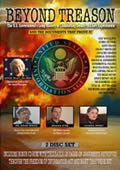Other
Dean
Articles:
DEATH
BY PROPAGANDA
PART 1 of 2
Dr.
Carolyn Dean, MD, ND and
Elissa Meininger
February 16, 2006
NewsWithViews.com
�The twentieth century has been characterized by three developments of great political importance: the growth of democracy, the growth of corporate power, and the growth of corporate propaganda as a means of protecting corporate power against democracy." --Alex Carey (Australian academic)
Looking back over how corporate power became the dominant force in our everyday life and how government now follows in lockstep to suit every corporate whim, it is useful to understand its origins. In all, it�s been a long, deliberate process that continues to become evermore sophisticated in its manipulation of us, the American public.
One of the principle architects in the takeover of the American mind is a fellow named Edward Bernays, who is considered the father of the American public relations industry. If his name doesn�t ring a bell, then maybe his Uncle Sigmund Freud�s will.
In 2002, the BBC broadcast a four-part documentary called �The Century of Self,� covering the story of the relationship between Freud and his American nephew, as Bernays learned about the human mind and how to manipulate the masses. Bernays� goal, from the early part of the 20th Century, was to be able to teach corporations how to make people want things they didn�t need through a variety of manipulative techniques appealing to people�s unconscious fears and desires.
What makes this production interesting is that it covers post-war America and illustrates how politicians and policymakers learned to use Freud�s ideas in their desire to control the masses as well. It shows how Sigmund Freud�s daughter, Anna, and his nephew Bernays, were central players, along with the U.S. Government, corporate America, and the CIA in believing that by controlling the masses via �engineering consent,� they could avoid the debacle of Nazi Germany where all the baser elements of the human character had committed atrocious acts.
Interestingly, during the 1960s, thanks to others in the psychological field, reactions against Freud�s ideas emerged, resulting in the idea of the �Me Generation� where individualism, not Freudian conformity, became the norm. Corporate America quickly adjusted by using focus groups, an idea first developed by the psychoanalyst industry, and learned how to further manipulate us by appealing to the unconscious desires in all of us to be �individualistic.�
�The Century of the Self� has been turned into a feature length documentary film that is now making the rounds in art movie houses here in the states. It is not yet available on DVD or VHS, but, nevertheless, is one of those �must see� films. [Read]
The basis upon which all of us are being manipulated, whether we realize it or not, rests on Freud�s basic theory that deep down, all human beings possess dangerous fears and desires that need to be controlled. The goal is to condition us like Pavlov�s dogs! The moment we hear our cue, we, in perfect unison, are motivated to think and act as we have been conditioned to do, even if the conditioning we received was outside our conscious awareness.
In Bernays 1928 book, Propaganda, which was recently re-issued, he talks about the invisible governance by manipulation.
"The conscious and intelligent manipulation of the organized habits and opinions of the masses is an important element in democratic society. Those who manipulate this unseen mechanism of society constitute an invisible government which is the true ruling power of our country. We are governed, our minds molded, our tastes formed, our ideas suggested, largely by men we have never heard of. This is a logical result of the way in which our democratic society is organized. Vast numbers of human beings must cooperate in this manner if they are to live together as a smooth functioning society."
A �smoothly functioning society� molded by advertising is what we now have as corporate America and Big Pharma think nothing of spending hundreds of millions of dollars on the promotion of one drug alone. The fact that the drug may be harmful further illustrates their understanding of the power of propaganda.
Bernays, thanks to his relationship to his Uncle Sigmund, believed that the �group mind� does not think but, instead, it has impulses, habits, and emotions. The first of these impulses, according to Bernays, is to follow the example of a trusted leader. In the area of medicine and disease, use of doctors, scientists, government officials, private or public agencies associated with public health, and prominent social leaders and celebrities all should be drafted to carry the propaganda message.
Bernays had a gift for cooking up extravagant public relations campaigns and one of his most famous ones was when he was hired by the American Tobacco Company. The head of the company, George Washington Hill, want to make Lucky Strikes the most smoked cigarette in America by opening up a whole new market of prospective smokers - women. At the time, people thought women who smoked were of low character and those in the better classes who did smoke, did so in secret.
The first part of the campaign was to launch the slogan �Reach for a Lucky Instead of a Sweet.� Arthur Murray, the famous dancing school founder was then engaged to claim that his dance instructors smoked to keep their slim figures instead of overeating the food and punch offered at public gatherings.
This propaganda pitch was quickly followed by finding a doctor to endorse the idea that smoking after a meal had several health benefits including being able �to disinfect the mouth and sooth the nerves.� Hotels were then urged to add cigarettes to their dessert menus! Menus prepared by House and Garden were circulated that recommended smoking instead of eating dessert as part of a healthful diet.
No venue was missed by Bernays. Homemakers were told to be sure to stock up on cigarettes as they were now household kitchen staples like salt, sugar and the like. The popular Ziegfield Girls formed a club so they could pledge giving up fattening food and take up smoking to control their weight. Bernays even asked a psychoanalyst colleague of Uncle Sigmund�s to claim that women in the workforce who had no desire to be homemakers and mothers had a need to see smoking as a feminist statement that they were equal to men--and cigarettes, to them, were torches of freedom.
A bevy of debutants were then drafted to join the fight for equal rights between the sexes by strolling down Fifth Avenue on Easter Sunday smoking their torches of freedom.
In my book, Death by Modern Medicine, in addition to providing detailed information about how Bernays built his reputation as America�s PR wunderkind, I also describe how Albert Lasker picked up where Bernays left off and became the �Father of Modern Advertising.�
This is another important branch of America�s propaganda industry. More importantly, I cover in detail Lasker�s central role in creating the money hungry machine we call the National Institutes of Health, which began when he retired as the richest man in the history of advertising.
Lasker and his wife, Mary, longtime board members of the American Cancer Society, realized that really big money could be had for research, if only the public could be convinced that tax dollars -- if poured into research year after year -- might lead to cures for all sorts of diseases, particularly cancer.
Over the years, Lasker had developed a number of Madison Avenue propaganda techniques similar to Bernays that he applied to motivate people to generously fund the American Cancer Society (ACS). Lasker�s campaign strategy was based on our fear of death and the hope that with enough money, we could cure cancer. He coached his friend, Elmer Bobst, president of the American branch of Hoffmann-LaRoche and later Warner-Lambert drug company, to start every fundraising speech with the following statement, "One in five of us here - every fifth person in the audience - will die of cancer.� He would then turn the fear he had engendered into hope with his next line, "We want to cure cancer in your lifetime�donate generously.�
Starting in the 1950s, those public donations he and his colleagues raised turned into vast pools of annual government funding when Lasker sold Congress on the idea of massively expanding the scope and size of the National Institutes of Health (NIH) to cover all diseases. Since then, charities like the American Cancer Society, the Arthritis Foundation, the American Diabetes Association and other charities have become the public relations arm for their respective diseases.
Disease charities, both nationally and at the local level, keep each disease visible through well-organized local fund drives, special public events, and the like, but most people don�t know that much of the money they give to these organizations locally may go to lobbyists in Washington to garner the big bucks �from our tax dollars! From a meager $3 million budget in 1945, and thanks to a well-oiled propaganda campaign that has gone on ever since, the NIH had been transformed into a fat $28 billion world headquarters for medical research by 2003. Today, there are 27 institutes and centers financed by taxpayers who all fear disease and all hope for a cure �if only enough money can be raised.
Albert Lasker coached his ACS associates on the need to keep cancer in the minds and hearts of the general public as much as possible. The idea was to make sure that when the annual fund drives came around, the people, like Pavlov�s dogs, would dig deep into their pockets and give. And so would Congress, convinced by Mary Lasker and her minions that the American people would be willing to use tax dollars to fund the search for cancer cures. And, more importantly, while each of us gives money, �to help the cause,� we also become �feel good� representatives to what has become a massive propaganda machine immersing us with all manner of fear and hope messages 24/7 so we are trained to want to raise billions for cancer research.
These days, the American Cancer Society promotes no fewer than 23 special propaganda campaigns each year, scheduled by the month for campaigns with names like �National Cervical Cancer Awareness Month,� �National Minority Cancer Awareness Week,� �Skin Cancer Detection and Prevention Month,� �National Cancer Survivors Day,� �Childhood Cancer Month,� and the like. As each of these cancer awareness calendar dates rolls around, appropriate press releases, photo ops and special publicity events are staged to make sure that there is not only news coverage of the moment, but also free advertising time (aka �public service announcements�) provided to make the public aware of this �feel good� cause.
Corporate America has by no means been left out in the cold on cancer promotion projects. While many corporations give checks and are willing to lend their name to sponsor public events, some go all out and make corporate commitments to raise money, using the full assets of the corporation to achieve what has become part of the official good-corporate-citizen agenda.
One of the most all-encompassing propaganda campaigns about the issue of cancer is that which is called �The Pink Ribbon Campaign.� This campaign is quite likely the largest propaganda campaign ever organized and has, over the years, followed, to the letter, Bernays� formula of getting the most prominent people, corporations, public agencies, celebrities private foundations involved in a single project. � Raise money to educate people about the perils of breast cancer.
All anyone has to do is google �Pink Ribbon Campaign� on the net to see just how much this campaign has become part of our shared global culture. It is not just the old American Cancer Society with a million volunteers going from door to door in their neighborhoods. It�s corporate America �partnering� with the project and carrying the torch to every hamlet and village on the planet.
|
Subscribe to the NewsWithViews Daily News Alerts! |
Annual �Walk for the Cure,� �Race for the Cure,� and other public events are staged in the name of the Pink Ribbon Campaign. Fabric companies have manufactured special �pink ribbon� designs so quilters involved with �quilt for the cure� quilting contests can do so with the official pink ribbon fabrics. Entire lines of clothing, especially jogging togs, have been designed along with accessories and hundreds of individual products so every entrepreneur can get in the act, not just the usual souvenir T-shirt folks. In addition, every corporation and retailer that wants to be a visible part of the local event has something tangible to sell �for the cause.� For part 2 click below.
Click
here for part -----> 2
ACT
FOR HEALTH FREEDOM NOW:
Go to www.friendsoffreedominternational.org
view and purchase the new movie on Codex and Free Trade called "We
Become Silent" by Kevin Miller
Also purchase "Death
by Modern Medicine." Proceeds from the sale of these products
are crucial to help us fund our health freedom action. For state action
go to: www.nationalhealthfreedom.org.
� 2006 Carolyn Dean -
All Rights Reserved
Dr. Carolyn Dean is a medical doctor, naturopathic doctor, herbalist, acupuncturist, nutritionist, as well as a powerful health activist fighting for health freedom as president of Friends of Freedom International. Dr. Dean is the author of over a dozen health books, the latest of which is "Death By Modern Medicine".
Elissa Meininger is vice president of Friends of Freedom International and co-founder of the Health Freedom Action Network, a grassroots citizens' political action group. She is also a health freedom political analyst and can be heard on the natural health radio show SuperHealth, broadcast weekly on station KEBC (Information Radio 1340) in Oklahoma City.
Website:
www.deathbymodernmedicine.com
Website: www.carolyndean.com
E-Mail: holeopharm@pol.net
Interestingly, during the 1960s, thanks to others in the psychological field, reactions against Freud�s ideas emerged, resulting in the idea of the �Me Generation� where individualism, not Freudian conformity, became the norm.











